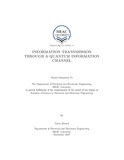Information transmission through a quantum information channel
Abstract
We consider the transmission of classical information over a quantum chan-
nel. The channel is expressed by an alphabet of quantum states. For an
example, we can express quantum states by photon polarization. For trans-
mitting information, we use speci ed set of probabilities. If we nd that the
receiver is unable to make separate measurement on the received letter then
we have to use Holevo theorem. From this theorem we see that, in such case,
the amount of information per letter we are sending cannot be larger than
the Von Neumann entropy H of the letter ensemble. It happens most of the
time that, the actual amount of information which will be transmitted is less
than H. However if we use block coding scheme which has options to choose
code words that respects the priori probabilities of the letter states then we
nd a di erent situation. In this case the receiver distinguishes whole words
rather than individual letters. In this way, the information transmitted per
letter can be made arbitrarily close to H. Block coding scheme helps us to
nd clear information of theoretical interpretation of Von Neumann entropy
in quantum mechanics. We use this experiment in superdense coding and we
consider this extension to noisy channels.

